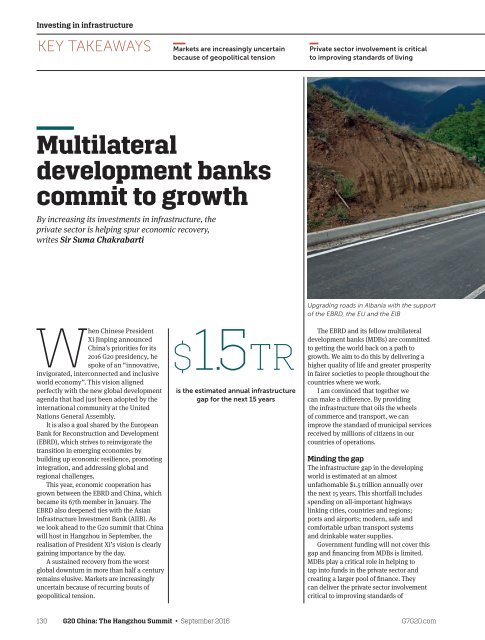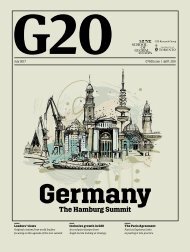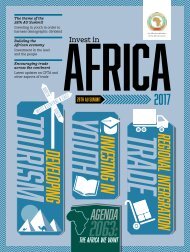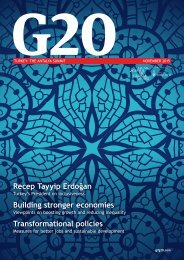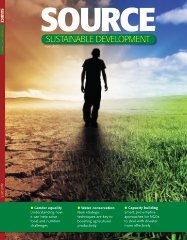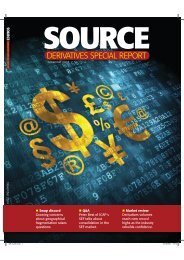G20 china_web
You also want an ePaper? Increase the reach of your titles
YUMPU automatically turns print PDFs into web optimized ePapers that Google loves.
Investing in infrastructure<br />
KEY TAKEAWAYS<br />
Markets are increasingly uncertain<br />
because of geopolitical tension<br />
Private sector involvement is critical<br />
to improving standards of living<br />
Multilateral<br />
development banks<br />
commit to growth<br />
By increasing its investments in infrastructure, the<br />
private sector is helping spur economic recovery,<br />
writes Sir Suma Chakrabarti<br />
When Chinese President<br />
Xi Jinping announced<br />
China’s priorities for its<br />
2016 <strong>G20</strong> presidency, he<br />
spoke of an “innovative,<br />
invigorated, interconnected and inclusive<br />
world economy”. This vision aligned<br />
perfectly with the new global development<br />
agenda that had just been adopted by the<br />
international community at the United<br />
Nations General Assembly.<br />
It is also a goal shared by the European<br />
Bank for Reconstruction and Development<br />
(EBRD), which strives to reinvigorate the<br />
transition in emerging economies by<br />
building up economic resilience, promoting<br />
integration, and addressing global and<br />
regional challenges.<br />
This year, economic cooperation has<br />
grown between the EBRD and China, which<br />
became its 67th member in January. The<br />
EBRD also deepened ties with the Asian<br />
Infrastructure Investment Bank (AIIB). As<br />
we look ahead to the <strong>G20</strong> summit that China<br />
will host in Hangzhou in September, the<br />
realisation of President Xi’s vision is clearly<br />
gaining importance by the day.<br />
A sustained recovery from the worst<br />
global downturn in more than half a century<br />
remains elusive. Markets are increasingly<br />
uncertain because of recurring bouts of<br />
geopolitical tension.<br />
$1.5TR<br />
is the estimated annual infrastructure<br />
gap for the next 15 years<br />
Upgrading roads in Albania with the support<br />
of the EBRD, the EU and the EIB<br />
The EBRD and its fellow multilateral<br />
development banks (MDBs) are committed<br />
to getting the world back on a path to<br />
growth. We aim to do this by delivering a<br />
higher quality of life and greater prosperity<br />
in fairer societies to people throughout the<br />
countries where we work.<br />
I am convinced that together we<br />
can make a difference. By providing<br />
the infrastructure that oils the wheels<br />
of commerce and transport, we can<br />
improve the standard of municipal services<br />
received by millions of citizens in our<br />
countries of operations.<br />
Minding the gap<br />
The infrastructure gap in the developing<br />
world is estimated at an almost<br />
unfathomable $1.5 trillion annually over<br />
the next 15 years. This shortfall includes<br />
spending on all-important highways<br />
linking cities, countries and regions;<br />
ports and airports; modern, safe and<br />
comfortable urban transport systems<br />
and drinkable water supplies.<br />
Government funding will not cover this<br />
gap and financing from MDBs is limited.<br />
MDBs play a critical role in helping to<br />
tap into funds in the private sector and<br />
creating a larger pool of finance. They<br />
can deliver the private sector involvement<br />
critical to improving standards of<br />
130 <strong>G20</strong> China: The Hangzhou Summit • September 2016 G7<strong>G20</strong>.com


